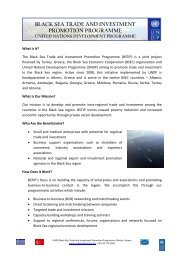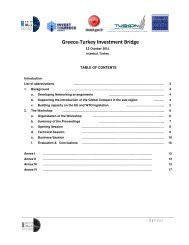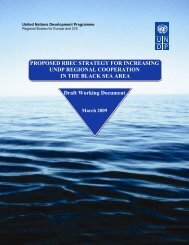Tradeflow Study - UNDP Black Sea Trade and Investment Promotion ...
Tradeflow Study - UNDP Black Sea Trade and Investment Promotion ...
Tradeflow Study - UNDP Black Sea Trade and Investment Promotion ...
You also want an ePaper? Increase the reach of your titles
YUMPU automatically turns print PDFs into web optimized ePapers that Google loves.
IV. Conclusion<br />
The study has undertaken a major evaluation of available quantitative indicators to identify<br />
sectors which exhibit strong intra-regional trade or investment potential. As highlighted<br />
previously, an important caveat to the analysis is that further information needs to be<br />
collected at the enterprise level in order to corroborate the findings of the study. In the<br />
absence of this firm level information, the study has attempted to use the latest trade<br />
indicators available to identify key strategic sectors for the region.<br />
Based on a comparison of actual trade flows <strong>and</strong> trade flows one would expect based on the<br />
size, proximity <strong>and</strong> other indicators of the respective economies of BSEC, the study identifies<br />
a number of sectors where countries are undertrading. The existence of untapped trade<br />
potential can reflect structural impediments to each country’s ability to trade but can also<br />
indicate the existence of asymmetric information whereby countries are unaware of<br />
opportunities of trade between them. This study attempts to provide an answer to the latter<br />
using indicators such as the revealed comparative advantage, intra-industry trade index,<br />
intensity <strong>and</strong> complementarity of trade indices, <strong>and</strong> other trade performance indices.<br />
The key strategic sectors in the manufacturing sector identified according to the gravity<br />
equation <strong>and</strong> trade flow analysis are:<br />
‣ Textiles <strong>and</strong> clothing (in particular HS Chapters 52, 54, 55, 60, 61, 62 <strong>and</strong> 64)<br />
‣ Food <strong>and</strong> beverages (in particular HS Chapters 17, 18, 19, 21 <strong>and</strong> 22)<br />
‣ Metal products (in particular HS Chapters 72, 73, 74 <strong>and</strong> 76)<br />
‣ Agricultural products (in particular HS chapters (03 <strong>and</strong> 08)<br />
‣ Wood products (in particular HS chapters 44, 48, 49 <strong>and</strong> 94)<br />
In the services sector, a number of countries have exhibited growth rates in the in exports of<br />
services which have outperformed the world performance. Moreover the region has a number<br />
of sectors which have a high <strong>and</strong> dynamic import dem<strong>and</strong>. The sectors which have exhibited<br />
the highest trade potential are travel, transportation <strong>and</strong> other commercial services. The<br />
greatest potential for trade lies in sectors where countries have made commitments to limit<br />
restriction on market access <strong>and</strong> national treatment. In this regard, the study identifies the<br />
following sectors as those with the highest indicative trade potential, based on a combination<br />
75/135






